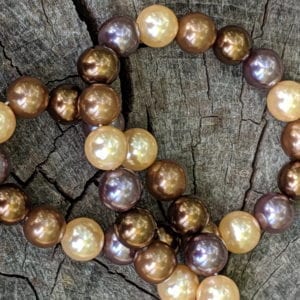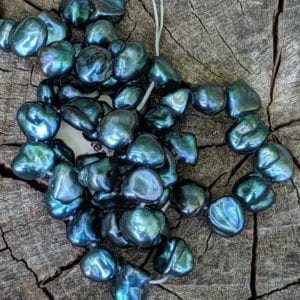Hiya!
I love this quote by Jackie Kennedy. It is my sentiment exactly regarding pearls. Last week I discussed the history of pearls. This week, as promised, I am going to delve more into the types of pearls that are out there today. even as I delve a bit deeper into the different types of pearls I will still only be touching the surface on the many different types and aspects of pearls.
I am about to take an online course. Once I do I’m sure I will have even more to discuss!
When we think of pearls most of us think of the white, round, traditional pearls like our grandmother may have worn or like the strand that Jackie Kennedy was famous for wearing. Granted these are the oldest type of pearl and the most commonly purchased pearls today.

There are 3 basic types of pearls, natural, cultured and faux or simulants. As I mentioned in my post last week, natural pearls are extremely rare and costly! Historically they were found in the Persian Gulf. Unfortunately most have been harvested. You may still may be able to find natural pearls but most will be small and quite costly.

Faux, imitation or simulants aren’t really pearls at all! Fake pearls are made of materials such as glass, shell, and plastic. They can be made to “imitate” a pearl’s luster. But they do not have the same depth as that of a high quality cultured or natural pearl. While it is relatively easy to determine a glass pearl from a natural or cultured pearl, it isn’t quite as easy to determine a natural pearl from a cultured one.

Shell or imitation pearls
Pearls are formed when an irritant of some sort finds its way into the shell of a mollusc. In reaction, the mollusc begins to produce layers of nacre around the irritant. In natural pearls this process happens well, naturally! While in cultured pearls man helps the process by inserting an irritant into the shell. Cultured pearls are considered real pearls!
Most of today’s real pearls fall into the cultured category. Within the cultured category there freshwater and saltwater. Within each of these categories there is a vast array of types, sizes, shapes and colors!
The most common type of saltwater pearl is the Akoya pearl. This is what most people think of when they think of pearls. They are grown in Chinese and Japanese waters. Akoya pearls are generally round, white or cream colored and around 2mm in size. Even though they can be found as large as 10mm. Mikimoto pearls are the most wildly distributed brand. Mikimoto were once considered the highest quality pearls and their price reflected that. Today they still command a high price but sometimes the quality doesn’t necessarily match the high price.

Akya Pearls
Tahitian pearls are considered the most striking, sought-after pearls on the market. Tahitian pearls are saltwater pearl. Despite the name Tahitian pearls come from other places than Tahiti.
The colors of these Tahitian pearls are completely natural and guaranteed to be unprocessed. While they often described as black, their colors cover the complete spectrum from dark-black to silver-white, and almost every color in between, including the most accepted peacock and green. Round Tahitian pearls are quite rare. They do come in range of baroque, drops and ovals that are quite valuable as well.

Tahitian or black pearl bracelet
The Rolls Royce of the saltwater pearls are South Sea pearls. They are grown primarily in Australia, the Philippines and Indonesia. South Sea pearls range in color form white to gold. They are the largest pearls grown today ranging in size from 8mm to 18mm. They are certainly a statement pearl!

Freshwater pearls are the most affordable pearls sold today. These type of pearls are grown in rivers, ponds and lakes, predominately in China. Many freshwater pearls are white and resemble the Akoya pearl in both size and shape. However, freshwater pearls can be produced in a huge selection of varying shapes sizes and colors. Many are treated and dyed to enhance color and luster.

The terms baroque and keshi are a type of pear per se, but rather refer more to the shape and way a pearl is formed. The terms are commonly misused. the term baroque strictly refers to the shape of a pearl. All irregular shape pearls are collectively referred to as baroque pearls. Whereas Keshi pearls are baroque pearls due to their irregular shape, but Keshi is used in relation to the formation process. A Keshi pearl is a result of an abnormality during the cultivation process where the there was a rejection of the nucleus by the mollusk.
What are your favorite pearls?

Various Baroque Pearls

Baroque Peacock Pearls

Keshi Pearls

Keshi Pearls
Shop for CKS pearl jewelry at www.cksventures.com
Until next time,
ENJOY!!
Cheryl
